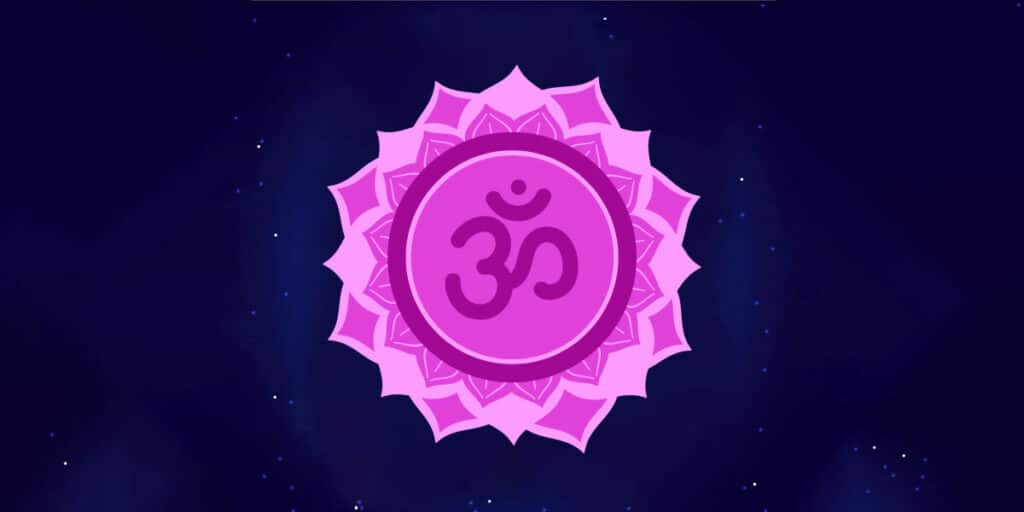Deciphering the guiding light of our lives: SAHASRARA CHAKRA
by Soha Akbar

The seventh and final of the primary chakras in the human body, the Sahasrara chakra, is known as the ‘crown’ chakra in English. When the spiritual abilities obtained through a well-balanced Ajna chakra reach higher levels, we are in the realm of the Sahasrara chakra. It symbolizes the bridge between physicality and spirituality: a connection to the divine consciousness.
What does Sahasrara mean and where is it located?
‘Sahasrara’ is a Sanskrit term meaning ‘thousand.’ It is named after its symbol: a lotus flower with a thousand petals. When all the petals are open, it unites the body, mind and spirit.
This chakra is located at the crown of the head, becoming the highest part in the body.
What is its element?
The element of the crown chakra is consciousness or thought, the highest level of awareness connecting us to the divine Self.
What is its colour?
The colour associated with this chakra is violet, representing purity, spirituality and enlightenment.
What is its symbol?
As stated above, the Sahasrara chakra is symbolized as a lotus with a thousand petals. Each of these petals represents a different facet of our lives, for instance, thoughts, emotions, actions, etc.
What is its seed mantra?
The seed mantra that stimulates and balances the Sahasrara chakra is AUM. It is a universal sound that can be heard by a still mind.
What is its significance?
In the broadest term, we can say that Sahasrara chakra acts as a guiding light that illuminates the path for our spiritual journeys. A person can experience spiritual awakening by learning how to balance this chakra and connect with it deeply. This awakening can also be felt in terms of simple things like cultivating a more optimistic view of life, inviting mental and emotional clarity, compassion, gratitude and self-acceptance. This will, in due course, lead to a greater sense of purpose and meaning in our lives.
Similar to the Ajna chakra, the Sahasrara chakra is also associated physically with the glands in the brain, namely, hypothalamus, pineal and the pituitary glands. Hence, an open and unblocked crown chakra helps in mental and emotional balance, a well-regulated circadian rhythm, better energy levels, better sleep quality and a better mood overall.
Blocked Sahasrara chakra
A blocked crown chakra will also have symptoms similar to a blocked third-eye chakra. When it comes to the physical body, a blocked chakra may be manifested as severe headaches, being overwhelmed with sensory inputs, irregular circadian rhythm, bad sleep patterns, insomnia, lethargy and fatigue.
Emotionally and mentally, there can be a loss of connection to one’s purpose in life, loss of motivation to complete any task or achieve something new, shorter attention spans, inability to focus, having confusing thoughts and inability to take decisions, increasing anxiety or depression, and a disconnect from spirituality.
Healing a blocked Sahasrara chakra
Meditation using the beej mantra AUM, while assuming the dhyana mudra, is helpful in the spiritual stimulation of the crown chakra. In asanas, inversions are helpful as they reverse the flow of energy in the body, and this helps to move prana towards the crown chakra. Also, since this chakra is associated with surrender to the Divine, relaxation postures are also beneficial. Some asanas to stimulate this chakra are Shirsasana (headstand), Balasana (child’s pose), Shasangasana (rabbit pose) and Shavasana (corpse pose).
One thing of importance here is that the energy to the crown chakra is also supplied by the other six primary chakras. Hence, balancing the other chakras also has a positive impact on the Sahasrara chakra.
Now, with reference to all the seven primary chakras that we have read about in the previous and this blog, we have seen how each chakra affects us when either blocked or unblocked. But how do we know what state any particular chakra is in? For this, self-reflection is extremely important. Take a moment, disconnect from your surroundings, and centre yourself by breathing slow and deep. Allow the senses to settle and calm down. Now think about what is it that is bothering you. Are you sleeping well? Do you have a consistent routine? Do you have extreme mood swings? What physical ailments are troubling you? How is your relationship with family and friends? How is your relationship to yourself? Do you treat yourself with empathy, kindness and compassion, or are you too harsh with yourself and too critical of what you do? Do you feel motivated to achieve your goals? Do you enjoy exploring your purpose in this life? So on and so forth.
Only when we are able to reflect on these points, we can accept that something is awry and we need help. Once we seek the right help, we can start understanding where we are facing blockages, and begin working on its improvement.
Even though all the chakras lie in the astral body, they have a huge impact on the physical body as well as the mental, emotional and spiritual state of a person. And all the chakras work in tandem, not alone. They are interdependent, so a blockage in any one chakra will definitely affect the other, even if in a small way. Hence, we need to ensure a good pranic flow throughout these energy centres. By doing so, we will be able to achieve a sense of contentment and holistic health in its true sense.
About the Author

Sohaila Akbar
Sohaila is a Yoga teacher, keen on bringing about positive changes in the lives of others through the knowledge that she has received from her teachers. Prior to this she was a school teacher working towards imparting academic, social and ecological knowledge to young learners. Sohaila is an avid reader of books and have an undying love for fiction. She prefers paperbacks and hardcovers over e-books anyday. She loves travelling, and a good cup of coffee is always welcome!
